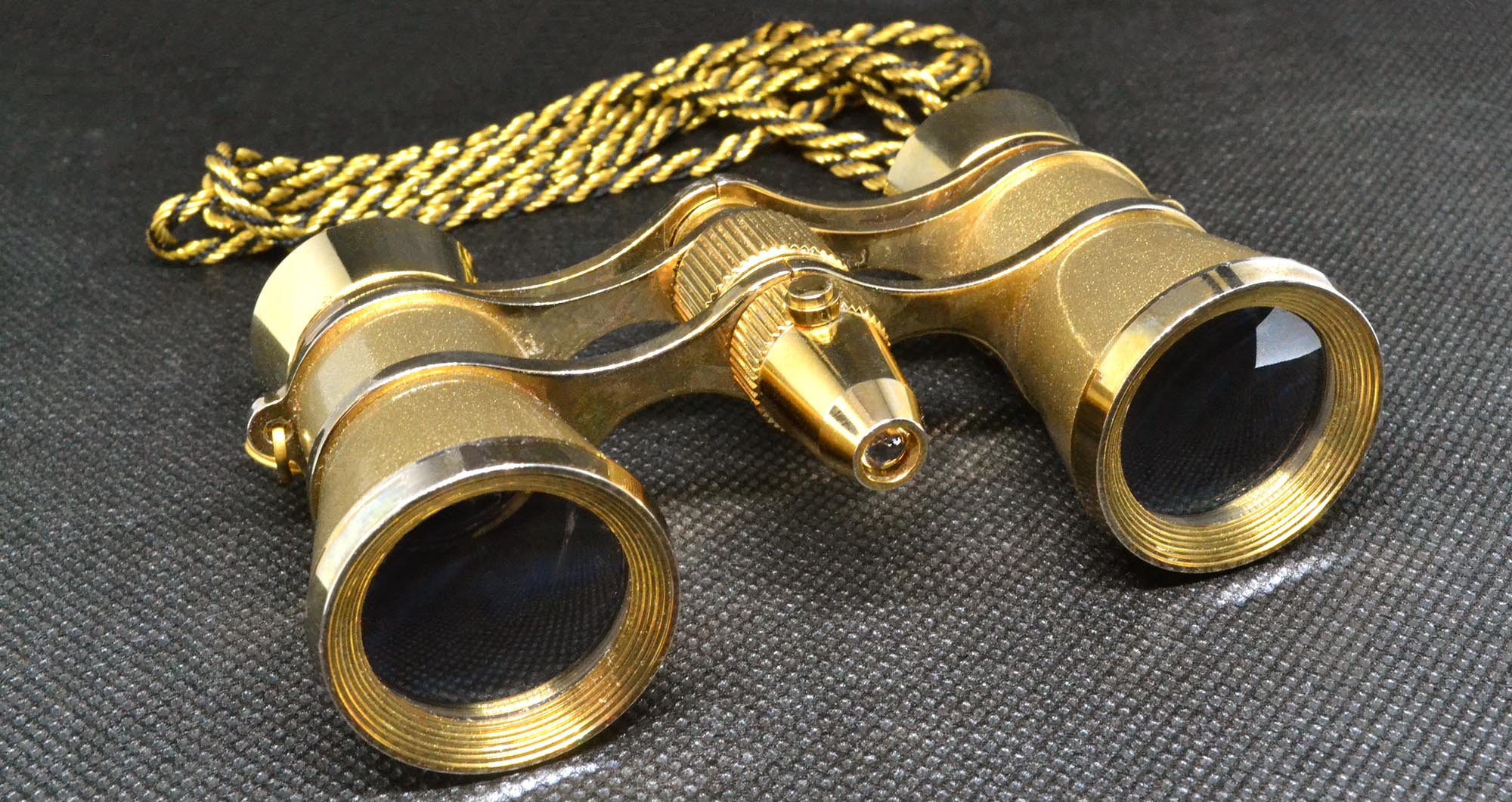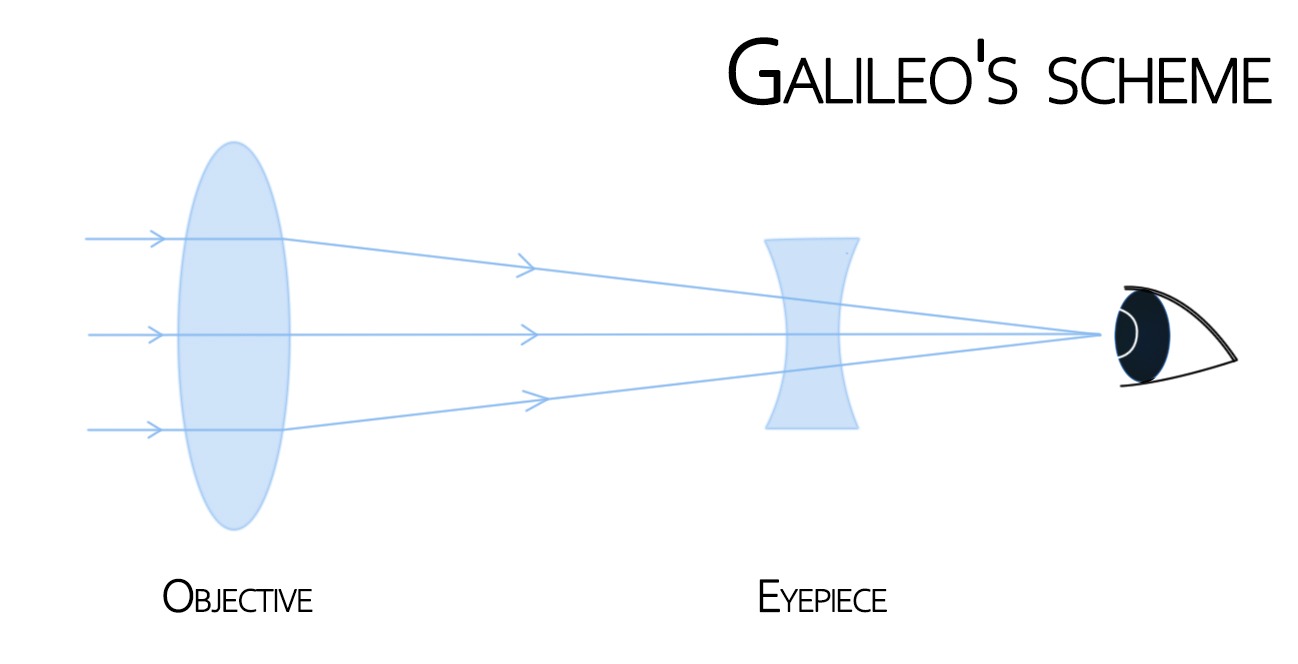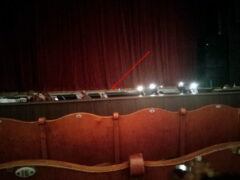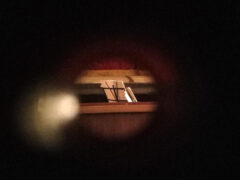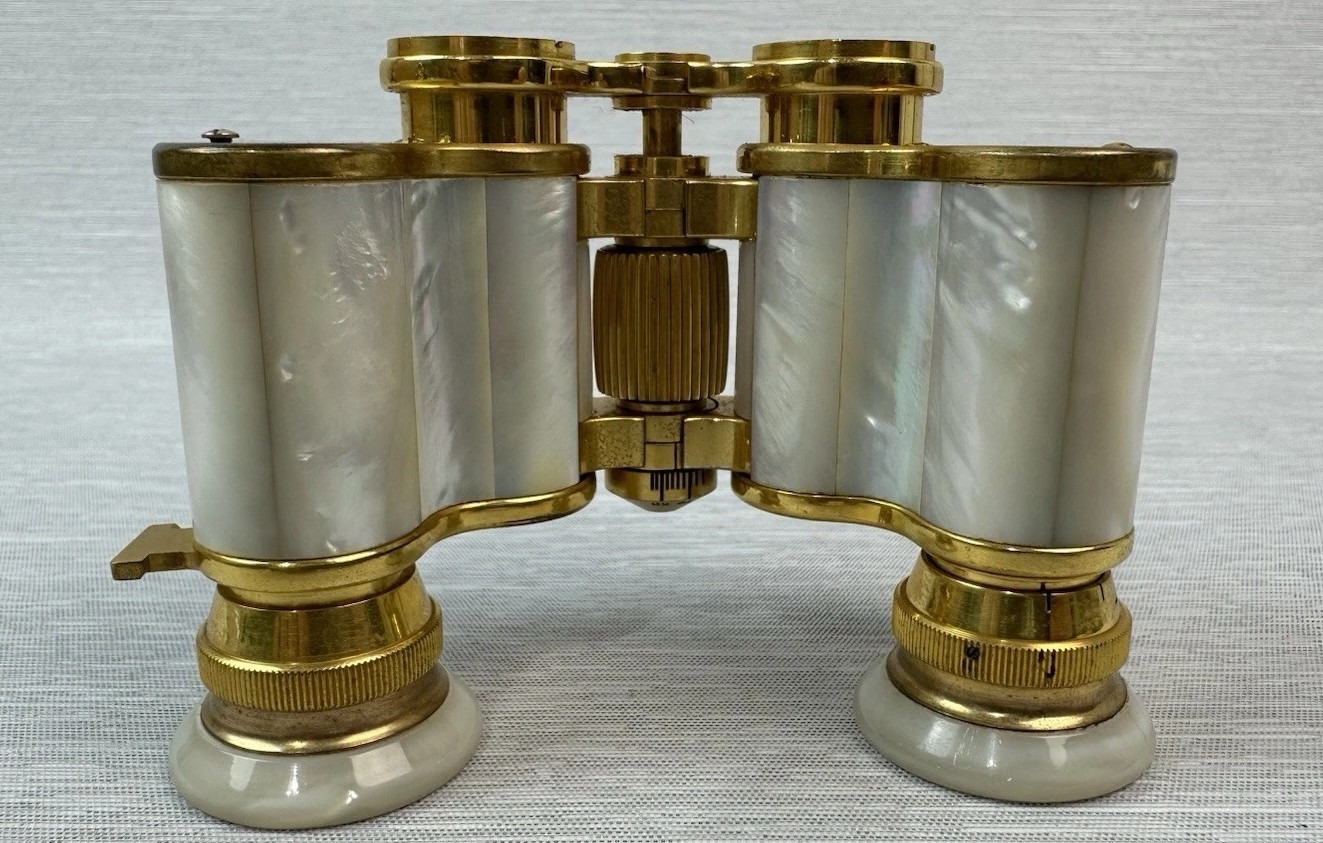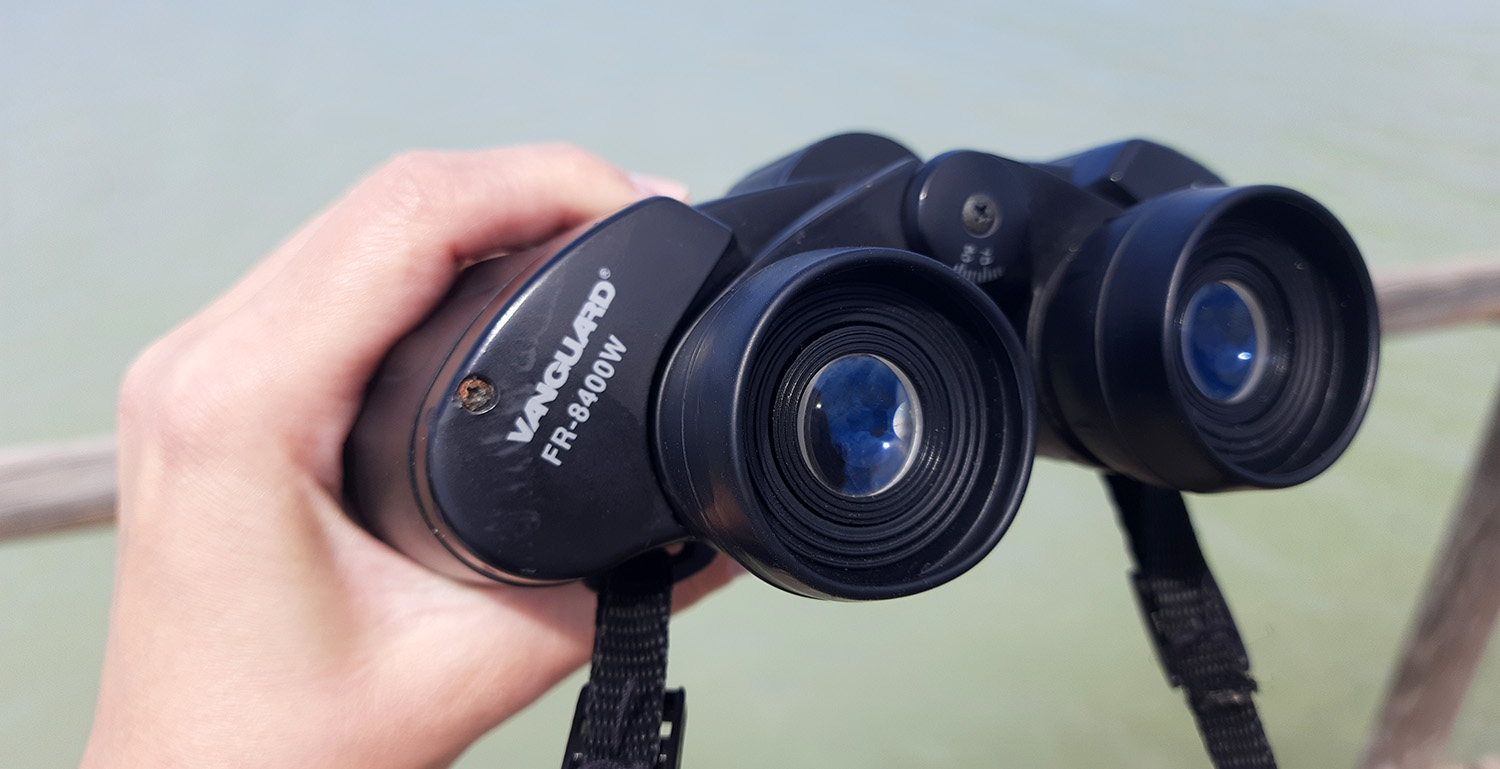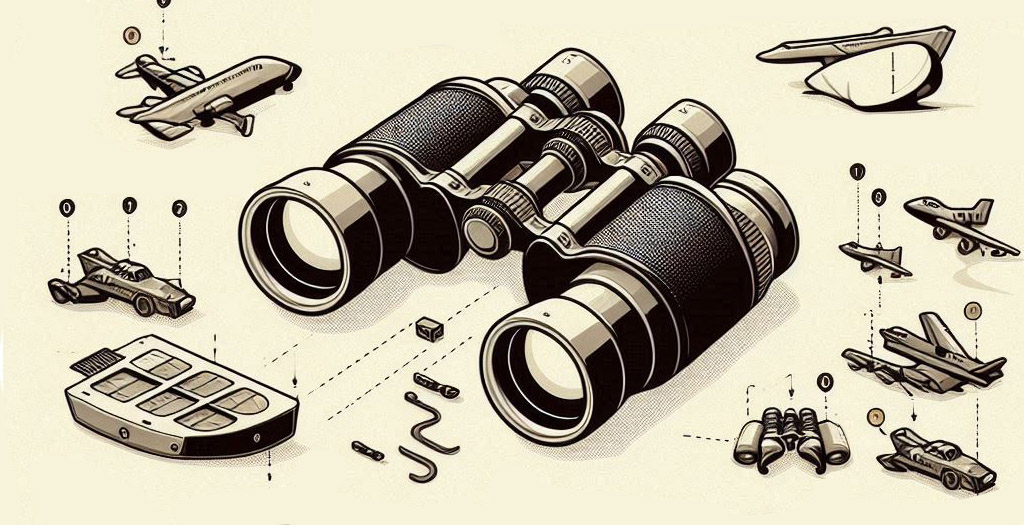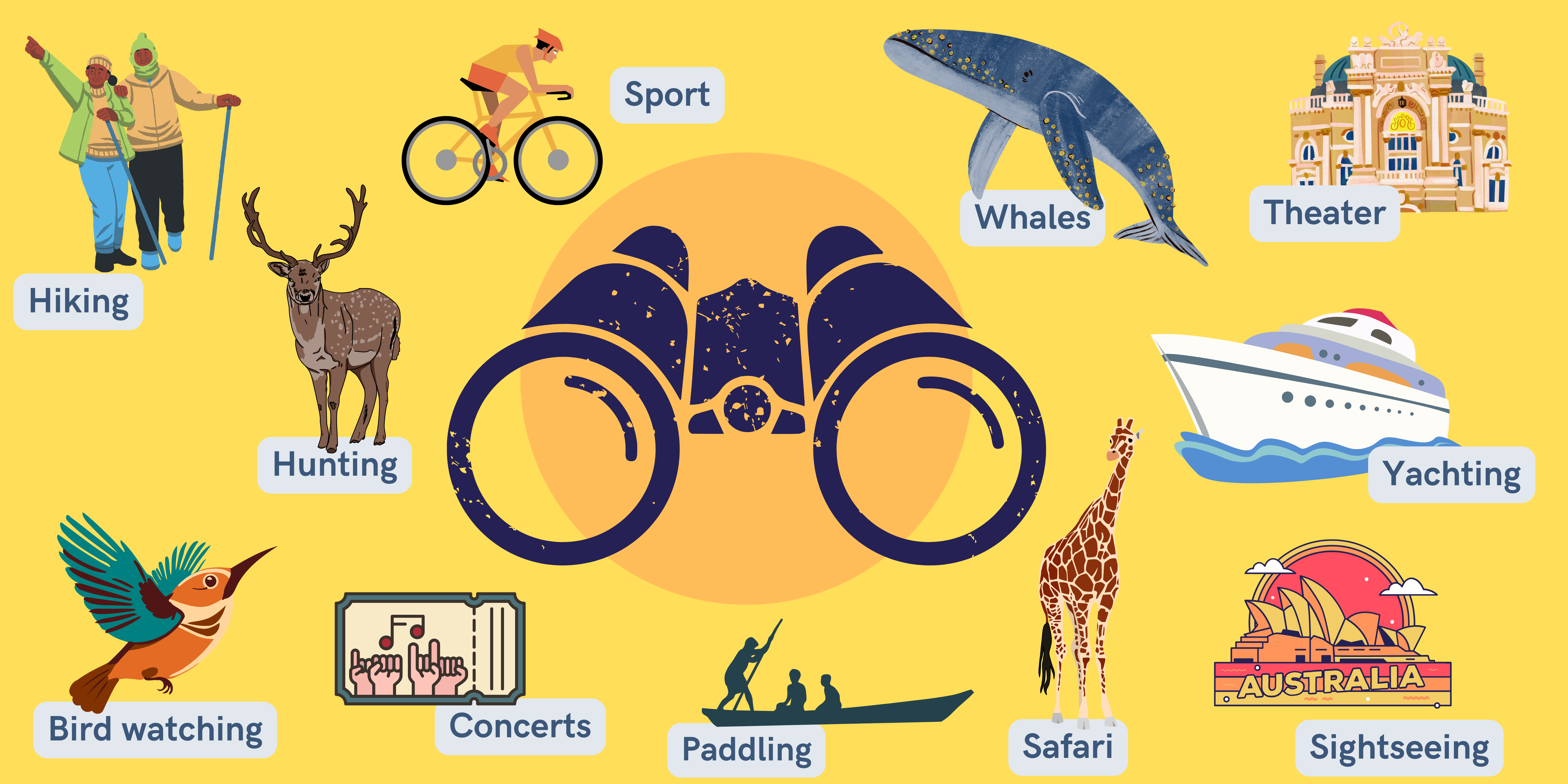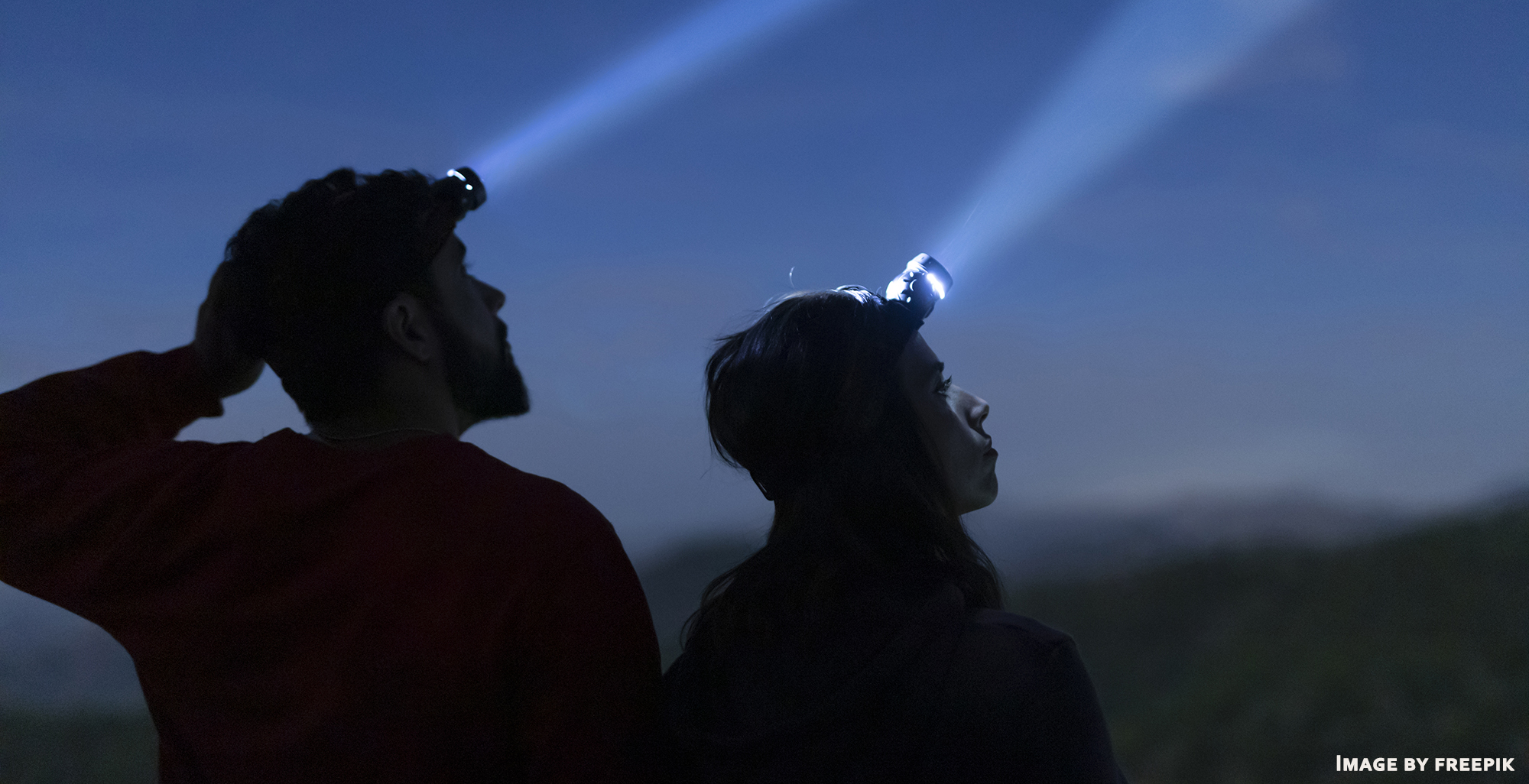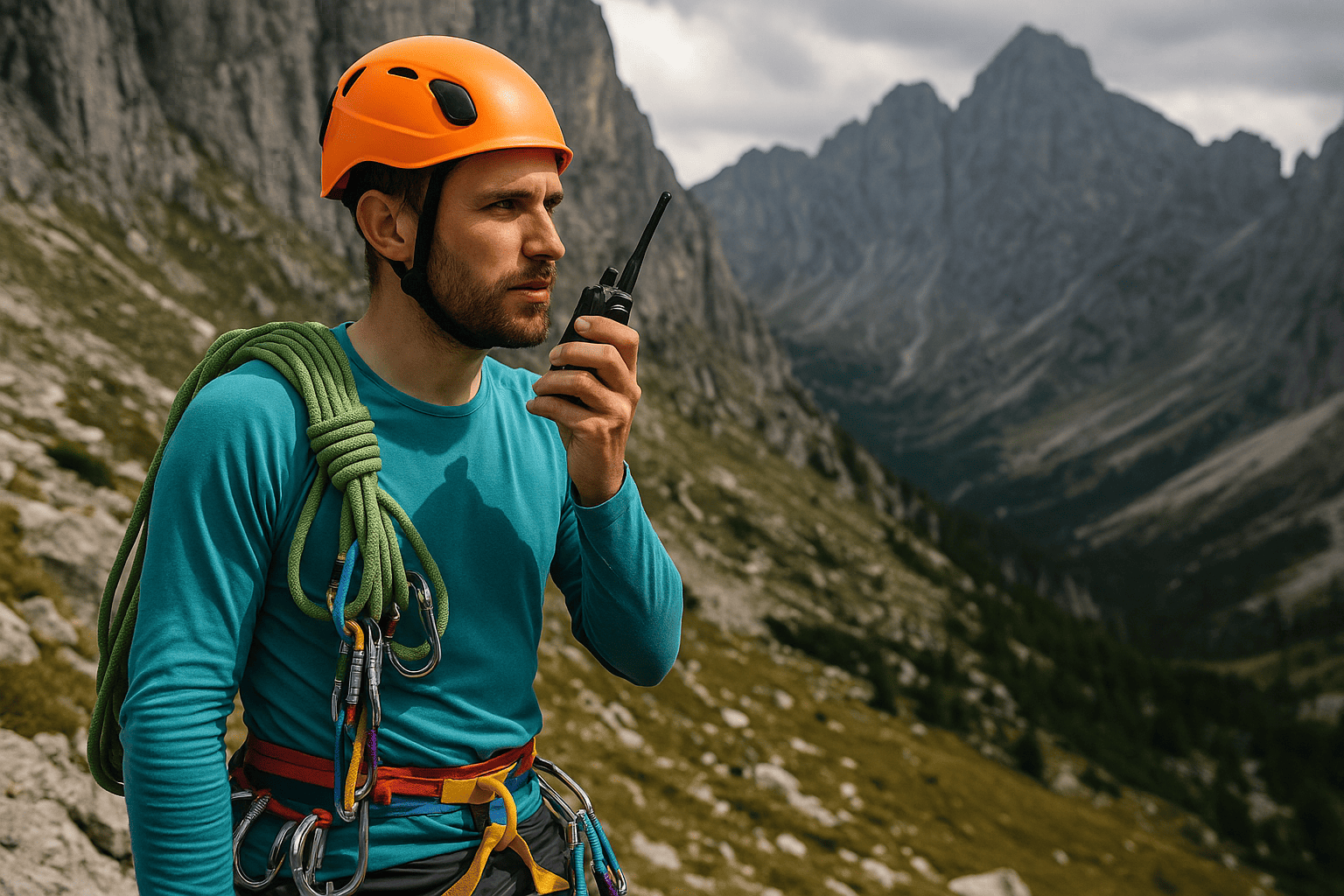At the end of the article you can see our video review. Click to pass!
Theatre binoculars are quite different from regular binoculars, and this is clear from the name. They are made specifically for use in darkened rooms to bring objects closer at a short distance. Here are their key differences:
| Feature | Theater binoculars | Regular binoculars |
|---|---|---|
| Usage | Indoors (theater, opera) | Outdoors, field observation |
| Optical scheme | Galilean | With prisms Roof or Porro |
| Magnification | Small (about 2–4x) | Medium or large (7x, 10x, 20x and more) |
| Objective diameter | Small (about 20–30 mm) | Medium or large (30–50 mm and more) |
| Field of view | Wide, designed for scenes and interiors | Narrower, focused on a specific point |
| Size and form | Compact, lightweight, elegant | Bulkier, designed for functionality |
| Lens coating | Usually simple, minimum coating | Multilayer coating for brightness and contrast |
| Weather resistance | Usually not waterproof or shockproof | Often waterproof, shockproof, and durable |
| Focusing | Simple, single wheel | Different mechanisms (central or separate), more precise |
| Weight | Light (about 200–250 g) | Heavier (500 g or more) |
| Design | Aesthetic, stylish | Practical, rubberized, field-oriented |
Why is it better to use opera glasses in a theatre, opera, or concerts?
✅ Wide field of view: Opera glasses allow you to take in the entire stage at once, focusing on both the performers and the scenery. This is especially valuable during visually rich productions.
✅ Low magnification: A magnification of around 2–4x is considered ideal for such use — you can see everything clearly while the image remains steady and natural.
✅ Compact and lightweight: Opera glasses are light, elegant, and small enough to fit in a pocket — very practical for venues where space is limited. They’re not weighed down by features that are unnecessary in a theater setting.
✅ Elegant design: They complement formal attire and the sophisticated ambiance of the theatre, enhancing the overall experience.
✅ Ease of use: Opera glasses are simple to use without complicated adjustments, letting you stay focused on the performance, not the optics.
In short, opera glasses are designed so that the viewer can comfortably follow the on-stage action while maintaining a sense of presence and immersion. They are not overloaded with features that aren’t needed in this setting and offer an ideal balance of specifications for watching live shows.
But aren’t there just compact binoculars?
Of course, modern manufacturers offer many compact binoculars that can also fit in your pocket. For example,
- the SWAROVSKI MY JUNIOR 7×28,
- LEICA ULTRAVID 10×25,
- and NIKON ACULON T02 10×21.
Their average size is around 90×100 mm — not much different from opera glasses. They weigh about the same, too.
BUT! Do you know why they’re not suited for the theater? Magnification and field of view. Most compact non-opera binoculars start at 7–8x magnification. The absolute minimum is around 6x — and even then, it’s hard to find a model that’s not a field binocular, or one that doesn’t come with massive 40–50 mm objective lenses.
If you happen to find a compact 5×35 model — sure, you could use that. But even that would be a stretch. That’s because when magnification goes above 4x and objective lenses are smaller than 30 mm, the field of view usually becomes too narrow. Will that bring you enjoyment during a performance? Hard to say.
You could use such binoculars to see costume details or facial expressions more closely — but for comfortably watching the entire show? They won’t do.
P.S. A little caveat: the field of view doesn’t depend *only* on magnification and objective size — you need to check the specs of the specific model. We’ll see that below.
Let’s compare the field of view of regular compact binoculars with opera glasses. We’ll look at four models from different manufacturers that are explicitly labeled as opera glasses.
Compact binoculars and their linear field of view (in meters at 1,000 m)
| Model | Field of View (m/1000 m) |
|---|---|
| SWAROVSKI MY JUNIOR 7×28 | 126 |
| LEICA ULTRAVID 10×25 | 90 |
| NIKON ACULON T02 10×21 | 87 |
| Bushnell 4X30 Xtra Wide | 262 (wow!) |
Opera glasses and their linear field of view (in meters at 1,000 m)
| Model | Field of View (m/1000 m) |
|---|---|
| Hands-Free “KabukiGlasses” 4×13 | 225 (a truly wide-angle binocular!) |
| Eschenbach Glamour Black 3×25 | 140 |
| Levenhuk Broadway 325F Opera 3×25 | 109 |
| Nikon DCF 4×10 | 175 |
So, generally, the field of view in opera glasses is wider than in regular compact binoculars. But in our quick lineup, there are two exceptions — wolves in sheep’s clothing, so to speak:
- The Levenhuk Broadway 325F Opera 3×25, specifically designed for theatre and opera, has a disappointingly narrow field of view of just 109 meters at 1,000 meters. A letdown 😐
- The Bushnell 4X30 Xtra Wide is a pleasant surprise — with a field of view of 262 meters! It’s marketed as a sports binocular and designed accordingly, but both its magnification and wide field of view make it suitable for the theatre. Still, it’s relatively large for an opera setting — 142 mm long — so its practicality is debatable.
Conclusion: Yes, you can use compact binoculars as opera glasses — but pay close attention to the field of view and magnification. The field of view should not be less than 140 meters at 1,000 meters, and magnification should ideally stay at or below 4–5x. For stadiums, higher magnification is fine — but again, mind the field of view.
Now let’s take a closer look at what exactly makes opera glasses different from standard binoculars.
The Galilean optical design, or Galilean refractor
First of all, opera glasses are typically based on the Galilean optical system. Unlike traditional binoculars, they do not use prisms. Regular binoculars, by contrast, are built with prism-based systems like Roof or Porro prisms.
Galileo Galilei constructed several telescopes using this optical design back in 1609. As shown in the illustration, the Galilean system consists of two lenses: a plano-convex converging lens as the objective and a bi-concave lens as the eyepiece. The key feature of this system is that it produces an upright (non-inverted) image, and the minimal number of optical elements helps reduce light loss.
In Galileo’s original telescopes, the field of view was narrow, brightness was low, and they suffered from chromatic aberration and edge distortion. Today, however, these drawbacks have been corrected in opera glasses thanks to modern optics and anti-reflective coatings.
The Galilean design, enclosed in compact barrels, provides very low magnification — just 3 to 4x. But that’s all you really need for theatre use. The simplicity of the design makes these binoculars lightweight, compact, and affordable.
In contrast, modern binoculars use prisms and more complex multi-lens systems. This allows for higher magnification with reasonably sized housings and excellent image quality. But such systems are significantly more expensive. For theatre purposes, all of that is unnecessary, which is why the Galilean design remains relevant in this context.
Design and housing
This difference was briefly mentioned above, but it’s worth emphasizing again. Since opera glasses are intended for indoor use, they are not built with rugged, waterproof housings. This makes them more affordable. Instead, they are often crafted in stylish designs — from vintage-inspired aesthetics to futuristic forms.
How far can opera glasses see?
Opera glasses aren’t designed for long-distance viewing — their main purpose is to bring you closer to the action on stage when you’re sitting far back in a theatre. They typically have a low magnification, around 2х or 3х, which lets you appreciate details like an actor’s facial expressions from about 20–30 rows back in a medium-sized theatre.
For example, in a renowned venue like the Royal Opera House in London, sitting in the balcony (about 30–40 feet or 9–12 m above the stage), 3х opera glasses will allow you to clearly see the actor’s gestures and expressions — a raised eyebrow or a slight smile — from 20 or more rows away. But if you were sitting much farther back, say in the upper amphitheatre, opera glasses wouldn’t be enough to resolve finer details; you’d need stronger binoculars with higher magnification.
Do binoculars work with glasses
Yes, opera glasses can usually be used with eyeglasses. For comfortable use with glasses, the binoculars should have an eye relief of at least 15 mm. Be sure to check this specification with the seller. However, even if the eye relief is shorter, in most cases you can adjust the image clarity using the focus ring — and you might not need your glasses at all. Binoculars can compensate for up to 6 diopters.
Opera glasses or binoculars for bird watching
Can you watch birds using opera glasses? Technically yes, but probably only if the birds are on your balcony. Opera glasses are not suitable for serious birdwatching.
- First of all, the housing is not protected against drops, moisture, or dust. Opera glasses are not designed for outdoor use — water and dust can get inside the housing, leading to fogging and dimmed lenses. Additionally, birdwatching binoculars usually feature a non-slip coating to improve grip.
- Secondly, the image quality likely won’t satisfy you. Opera glasses use mid-grade optics, most commonly BK-7 glass. This is sufficient for viewing actors on stage, but for observing birds in natural conditions, BaK-4 or low-dispersion ED glass is generally preferred.
- Most importantly — magnification. Opera glasses simply don’t offer enough magnification for birdwatching. You typically need 6–8x magnification to see birds in their natural habitat. And to achieve this level of magnification without a dark, tunnel-like image, you need larger objective lenses. Standard birdwatching binoculars are usually 8×42. By contrast, opera glasses typically have 30 mm objectives.
Which manufacturers offer opera glasses? There are quite a few brands — some offer entire lines of opera glasses, while others produce just a few models.
Nikon Opera Glasses
In the past, Nikon released a line of opera glasses called DCF 4×10. Though no longer in production, they can still be found in stores, on eBay, and even Amazon. These binoculars use a roof prism system, offer 4x magnification with 10 mm objectives, and have a respectable field of view of 175 m at 1000 m. All elements are fully multi-coated. They weigh just 65 g. One standout feature is their futuristic design and slim profile — only 19 mm thick.
More recent Nikon opera glasses include the 6×15 and 7×15 models from the Anniversary series, released to celebrate the 80th anniversary of Nikon’s first binoculars.
The Nikon 6×15 Anniversary is a recreation of a 1922 binocular: metal housing, lightweight, wide field of view, and outstanding coated optics.
The Nikon 7×15 model offers increased magnification in a very distinctive housing. It’s a tribute to the 1917 model, also lightweight and with a decent field of view (around 128 meters). The Nikon Anniversary series is ideal for enjoying performances from the back rows.
Vintage opera glasses or Zeiss Opera Glasses
Today, Carl Zeiss no longer manufactures opera glasses, instead focusing on premium lines of field, nature, and observation binoculars (such as the Victory, Conquest, and Terra series). But the company dates back to the mid-19th century and released its first line of opera glasses the same year it obtained its first binocular patent — in 1893.
From the 1910s to 1930s, Zeiss began producing lightweight Galilean opera glasses with mother-of-pearl and leather finishes — designed for opera, theatre, and other performances. These are sometimes referred to as “Theaterglas” or “Operngläser” in German. They were Galilean-style binoculars with 2x to 3x magnification. The lenses were made from high-quality Zeiss optical glass, producing a bright and sharp image even in dim lighting. The housings were elegantly finished with leather and mother-of-pearl, giving them a jewelry-like appearance suited to the theatrical aesthetic.
Today, some of these vintage models can still be found on eBay. For example, Carl Zeiss Jena Pearl Teleater opera glasses from 1922 typically sell for around $180. Take a look at the design:
This photo was kindly provided by seller lodestar24 on eBay.
They truly knew how to make beautiful things back then!
Levenhuk Opera Glasses (on a stick)

The Levenhuk brand offers an entire line of opera glasses under the Broadway name, distributed worldwide. This series includes budget-friendly models in elegant metal housings — available either as lorgnettes (on a stick) or with a chain. Theatre enthusiasts and older users particularly appreciate the on-a-stick versions — elegant lorgnettes with folding handles.
Most Levenhuk Broadway opera glasses feature 3x magnification and 25 mm objective lenses. The optical system is the standard Galilean refractor. Many models include a built-in LED light in the central bridge — a handy little feature that helps illuminate the program or your seat number in the dark, once the performance has started. Be sure to check out our video review of the Levenhuk Broadway opera glasses at the end of this article.
TOP-5 Best Opera Glasses
We conducted a fairly extensive analysis of the opera glasses currently offered by various manufacturers and selected the most outstanding and popular models. Here’s our top list:
- German quality, German assembly.
- 3× magnification, 25 mm objectives, metal body with luxury finishes.
- Compact and lightweight, comes with a chain and case.
- Excellent brightness and contrast thanks to multi-coated lenses.
- Price: around €117 ($130–160).
Levenhuk Broadway 325N
- Classic “lorgnette” design with handle and built-in LED light.
- 3× magnification, 25 mm objectives, metal housing, available with chain or folding handle.
- Multi-coated BaK-4 lenses — bright and high-contrast image.
- Narrow field of view: 109 m, but it’s a budget model.
- Price: about €53 ($60).
Ade Advanced Optics 4×10
- Compact roof prism design, 4× magnification, 10 mm objectives.
- Very lightweight (~62 g), wide field of view (≈160 m at 1000 m).
- Price: about $37.
Aomekie Opera Glasses 3×25 (budget)
- Attractive design with chain, 3× magnification.
- Good entry-level viewing experience, solid quality for a budget product (~$43).
- Price: around €42–45.
Hands-Free Met Logo “KabukiGlasses”
- Completely unique design resembling stylish eyeglasses — hands-free use.
- Impressive 225 m field of view — much wider than most opera glasses.
- Price: around $150. More expensive than others on the list, but well worth the investment.
FAQ
Are opera glasses better than binoculars?
Opera glasses are designed for a very specific use case, and they perform that role perfectly. In a theatre, museum, exhibition, or concert setting, they’re more appropriate than standard binoculars.
What magnification is best for opera glasses?
Opera glasses typically offer 2x to 4x magnification, occasionally up to 5x. The most common magnification is around 3.5x. A 5x model may be more suitable for large venues and back rows.
Are opera glasses still a thing?
Absolutely! No doubt about it. Opera glasses are likely to endure as long as theatre itself. Over time, only the design and optical quality evolve — with improved coatings for brighter images and better light transmission. But the core purpose of opera glasses remains as relevant as ever.
Some materials of this article were transferred from my old site lookforword.net.
